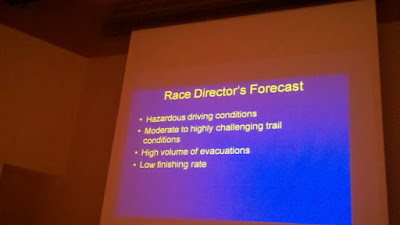 Beat and I finished the Susitna 100 on foot in 41 hours and 16 minutes. All I can say about it right now is — wow, that was really hard. The race was actually much harder than I anticipated, not only in physical effort, but also pain and cold management. As it turns out, traveling 100 miles really is a lot more difficult without a bike — who knew?
Beat and I finished the Susitna 100 on foot in 41 hours and 16 minutes. All I can say about it right now is — wow, that was really hard. The race was actually much harder than I anticipated, not only in physical effort, but also pain and cold management. As it turns out, traveling 100 miles really is a lot more difficult without a bike — who knew? It was an interesting year for the Susitna 100. The weather was clear and cold, with colorful skies and incredible views during the day, and overnight temperatures dipping as low as 19 below with a 20 mph headwind. The trail was well packed, awesome for cycling, but the new snow made for tough footing. The fine powder was still very sandy where our little feet punched through. It was very taxing to maintain a 2.5 walk pace, much like trying to run 100 miles in crusty sand. The snow was also very cold, which makes it very sharp — meaning no glide for our sleds. There was a lot of resistance all around.
What else can I say about it? My feet hurt a lot. So do my legs. No injuries, but the usage pain alone led to a minor mental breakdown around mile 70, when I realized I was going to have to endure the pain I was in for at least 13 more hours. Beat and I decided to stick together from the beginning and it was really great to have him around for my low points, even when I got really grumpy and at one point snapped at him that I hoped I didn't finish the Susitna 100 so I wouldn't qualify for any other dumb 100-mile foot events. He also helped me zip up my coat when my fingers froze and refused to work amid a desperate layer-adding effort in the intense windchill on the Yentna River. Did I mention it was really cold? That also made the run that much harder. Yeah, it's hard to eat and drink when your whole face is crusted in ice.
I'll write up the race report at a later date. It really was one of the more intense experiences of my life — did I also mention we were out in the cold without sleep for two nights, not just one. We certainly did a checkpoint comfort tour with the five indoor stops on course, so we did have chances to warm up and reconnect with the real world. But by the second sunset, with all that leg and foot pain coursing through my nerves, my thoughts ventured into new head spaces I'd never before found. Which is the reason why I seek out this sort of stuff — long, difficult slogs that are way over my pay grade. I need to occasionally be reminded that I am weak and small and the world is huge and incredible and mean, and even the world is just weak and small in the grand scheme of the universe. I fall in love the world from this perspective. It's consistently awe-inspiring, even when it's reduced to the tiny beam of my headlamp.
And it was so much fun to share it with Beat, with my new friends Steve and Danni, and with many of the Alaska cyclists I've met over the years. It was incredible to return to Alaska. It helps me realize how much I really miss it, but also that it's still here. I took lots of pictures, and even a bit of video. Check back again!








































